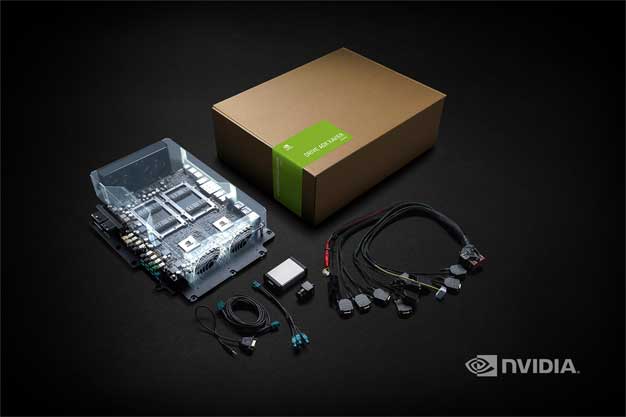NVIDIA's Rolls Out Next-Gen DRIVE AGX DevKit For Autonomous Vehicles
NVIDIA is into a lot more these days than than just gaming video cards and GPUs for professionals. The company announced that it has a new DRIVE AGX DevKit that will be launching on October 1. The kit includes software and hardware needed for complete self-driving auto development. NVIDIA says that DRIVE AGX is designed to allow companies to develop and test customized autonomous driving technology with a streamlined production process.
The kit includes the DRIVE AGX Xavier car computer, the vehicle harness to connect the platform to the car, international power supply, camera sensor, and other accessories needed. DRIVE AGX is part of NVIDIA's AGX platform meant to power autonomous robots, medical devices, and cars. The current software that the platform runs is NVIDIA DRIVE Software 1.0, and it's able to run all operations needed for self-driving including the huge amount of data collection needed for safe operation, obstacle and path perception, advanced driver monitoring, and in-vehicle visualization.
NVIDIA notes that the release also includes DriveWorks modules for the sensor abstraction layer along with computer vision and image processing libraries to streamline the development of autonomous autos as much as possible. The entire platform is open so that companies working with the devkit can build their applications on the base software and enhance it over-the-air. That base software is a very important part of the DRIVE AGX system that allows the autonomous rides to perceive their surroundings to allow them to operate safely without a human behind the wheel.
DRIVE Software 1.0 supports the ability to classify a wide range of obstacles the auto might encounter during normal operation. The software works with DriveNet deep neural network to allow the detection and classification of objects in the environment by the car and the ability to track those objects identified from one frame to the next. LaneNet and OpenRoadNet allow the vehicle to identify lane markings and detect the drivable space. NVIDIA's software also includes a tool for data recording to allow the manufacturers to collect time-stamped, real-time data from sensors on the vehicle for testing, training, and validation.
The system supports a driver-facing camera; developers can build applications on the DRIVE IX SDK that can track driver facial expression to know when the driver is inattentive or drowsy. Visualization capabilities in the system allow the passengers inside the vehicle to see what the vehicle is seeing. NVIDIA says that capability will help to build trust between the passenger and the vehicle.
The Xavier DevKit platform is scalable so manufacturers can develop their autonomous systems using a DRIVE AGX Xavier with a single Xavier SoC or a DRIVE AGX Pegasus using dual Xavier SoCs and dual next-gen GPUs inside. That allows the company developing the auto tech to choose what configuration works best with their driverless vehicles and to develop a range of applications from advanced driver assistant systems to full driverless vehicles. The system will launch October 1, and NVIDIA notes that early access customers have been using Xavier since the beginning of the year.



